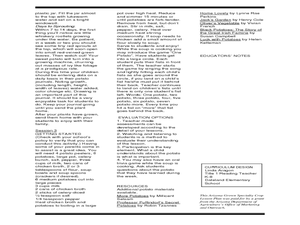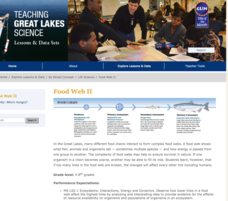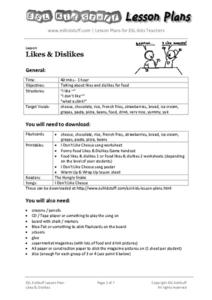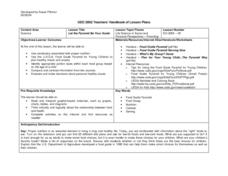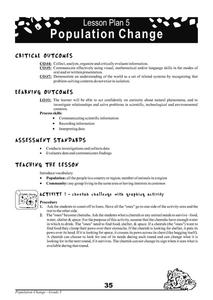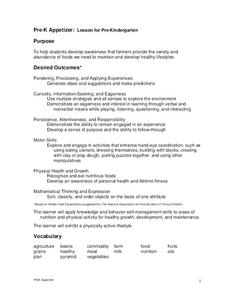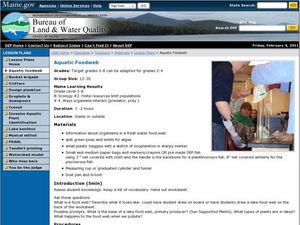Curated OER
From Mashed to Riches
Students discuss the uses of a potato. In this food group activity, students identify the five food groups and which one the potato belongs to. They create potato printing, compare different kinds of potatoes, grow a potato plant, and more.
Pimsleur
Dining Out in Brazil
Learn about Brazilian food and pick up some Portuguese vocabulary along the way. After studying the vocabulary, class members complete the provided worksheets. They then work in pairs to write sentences and play a vocabulary game as a...
Michigan Sea Grant
Food Web II
A food web consists of complex food chains and the more complex the web, the better likelihood of survival. Learners compare and contrast food webs and food chains and discuss concepts like the predator-prey and consumer-producer...
ESL Kid Stuff
Likes & Dislikes
Everyone has different preferences when it comes to food. Kids discuss the foods they like and dislike in a series of activities that include magazine cut-outs, singing a song about cheese, playing a group game, and reading a short story...
Curated OER
Making Healthy Food and Activity Choices: Putting the Pyramid Together
Students work with the Food Guide Pyramid. In this Food Guide Pyramid instructional activity, students draw a large rendering of the food pyramid on a piece of butcher paper. They cut out pictures of foods and place them on the food...
Curated OER
Food Chains
Fourth graders study food chains, producers, consumers, and decomposers. They play a food chain game and create food chain mobiles or posters. They take a nature hike around the school and observe various parts of a food chain.
Curated OER
Nutrition Vocabulary Word Searches
Pupils complete word searches based on nutrition vocabulary. In this nutrition lesson plan, students choose the food group and select a word search based on the group.
Curated OER
Food Chain: what's for dinner?
Fourth graders identify where foods came from and sequence a food chain. In this food chain lesson, 4th graders define vocabulary related to food chains and order a food chain. Students follow the energy of a food chain. Students...
Curated OER
Wetland Food Webs
Students study life science. In this food webs and food chains comparison instructional activity, students examine the wetlands to discover the relationships that exist between the animals that live there. They participate in group...
Consortium for Ocean Science Exploration and Engagement (COSEE)
Arctic Smorgasbord
Though the walrus spends roughly one third of its time on land, it eats organisms that live on the bottom of the ocean. The first in a series of five, the lesson uses a variety of plant and animal cards to have scholars build an arctic...
Curated OER
Let the Pyramid Be Your Guide
High schoolers chart foods on the food guide pyramid and design nutritional food plans that include all the food groups.
Curated OER
The Food Chain Game - A Lesson in Ecosystems
Learners are divided into three groups, herbivores, omnivores, and carnivores which receive a certain number of lives. Once in their ecosystem (outside or the gym), the carnivores chase and eat either the herbivores or omnivores, the...
Polar Trec
Arctic Smorgasbord!
Two blooms of phytoplankton, instead of just one, now occur in the Arctic due to declining sea ice, which will have widespread effects on the marine life and climate. In small groups, participants build an Arctic food web with given...
Montana State University
Everest Extremes: Biodiversity
How many animals can live in a climate as cold as Mount Everest's? Find out with a science lesson all about biodiversity. Activities include research, presentations, group work, coloring maps, and a simulation of a food web.
Curated OER
Is It Paella?
Students observe a picture of a paella dish. Using a worksheet, they follow directions to explore international dishes. Afterwards, students play a similar game. In groups, students describe dishes and play a vocabulary game.
Cheetah Outreach
Population Change
Your youngsters become cheetahs in search of food, water, shelter, and space in a fun physical game that does a fantastic job of representing fluctuating species population based on resources available over years.
Curated OER
Field Trip to the Watsonville Wetlands
Students explore the differences between food webs and food chains. In this wetland lesson students play a food web game and go on a scavenger hunt.
Curated OER
The Dangers of Being Obese/Overweight
Third graders determine if they are eating healthy. In this healthy living lesson, 3rd graders watch a video titled Happy Health and review the food pyramid. Students create a spreadsheet where they list their food intake for the week...
Curated OER
Bugs in the Woods
Second graders identify insects and plants in the forest ecosystem in a structured field trip with stations and activity booklets. In this bugs lesson, 2nd graders explore the ecosystem of the forest, complete the booklet and play...
Curated OER
Pre-K Appetizer
Students understand there are healthy and not healthy food choices. In this food pyramid lesson, students learn to make healthy choices by playing a traffic light game. Students recognize raw foods from the farm may not be ready for...
Curated OER
Aquatic Foodweb
Students explore what a food web is. In this science instructional activity, students examine how nutrients and other pollutants enter a lake and play a food web game whereby students pretend they are either zooplankton,...
Curated OER
Making Healthy Eating Choices for You and Others
Students use the USDA food guide pyramid to choose items for a balanced diet. In this food pyramid lesson, students play a game naming the items and their foo groups. Students participate in cross curricular activities...
Curated OER
Social Studies: Food and Dining in Cameroon
Students review their findings on Cameroon and play a vocabulary game. Using provided recipe packets, they present a mock cooking show with a student narrating in French. They role-play as exchange students and write letters home about...
Curated OER
Puffin Patrol
Bird diversity and the majestic puffin are the topics of today's lesson. Children discuss and look at images of puffins, and then they use felt to put a puffin body together. After that they talk about what and how puffins eat. They get...
